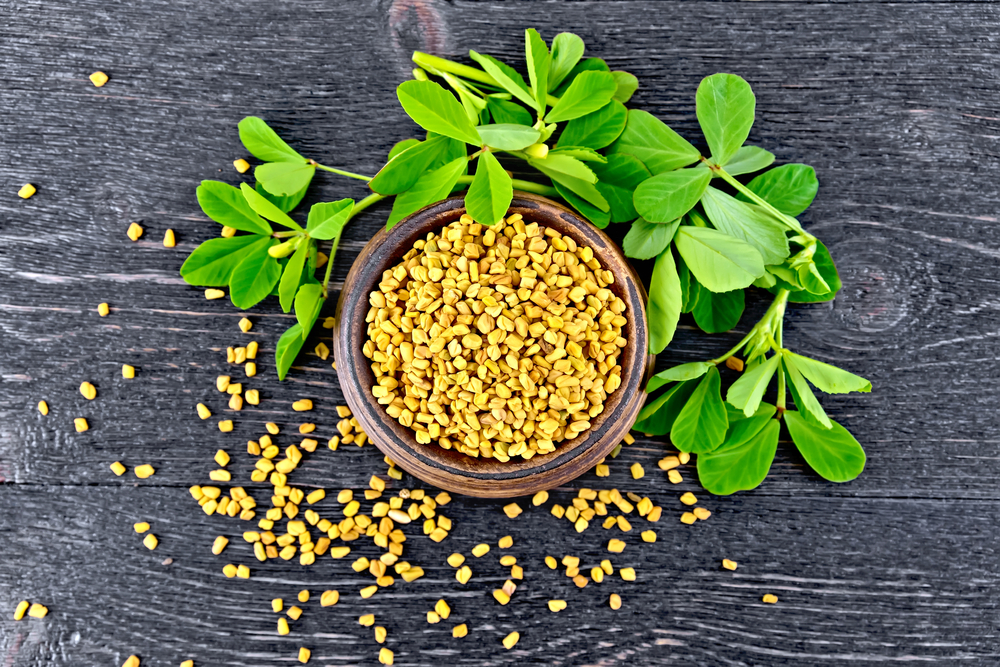Fenugreek for Glucose Management and Breastfeeding
Fenugreek for Glucose Management and Breastfeeding
Fenugreek (Trigonella foenum-graecum) is a member of the Fabaceae (pea) family, a medicinal herb with a wide range of clinical, culinary, and cosmetic applications. Also known as Greek clover, alhova, mehi, medhika, and hu la ba, the leaves of the annual, yellow-flowered fenugreek plant are reminiscent of clovers; Trigonella is derived from the ancient Greek word for “three-angled.” Its seeds taste bitter and are known for use in cooking and medicine, particularly traditional Ayurvedic medicine, traditional Arabian, Greek, and Indian medicine, and traditional Chinese medicine. Fenugreek extracts are also common ingredients in soaps and cosmetics.1
T. foenum-graecum originates from the Mediterranean, southern Europe, western Asia, and North Africa. Historians estimate that fenugreek was first cultivated as early as seventh century B.C. Fenugreek seeds can be soaked and crushed into a paste. Fenugreek is a common spice used in Egyptian, Indian, and Middle Eastern cuisine, often found in tea blend infusions, curries, and a wide variety of vegetarian dishes.1
Historical Use of Fenugreek
Fenugreek was traditionally used to support levels of mucus and phlegm in the lungs and bronchial tubes.2 For example, fenugreek may have been used to address mucus-related health conditions, such as clearing congestion in the lungs and upper respiratory tract. Fenugreek was historically used as a throat cleanser and mucus solvent, such as relieving the impulse to cough. Additionally, fenugreek is historically associated with lymphatic cleansing, such as rinsing cells of toxic wastes and cellular debris. Fenugreek is also known as a diaphoretic, inducing perspiration and aiding in the body’s natural detoxification process. Overall, fenugreek’s historical context typically resides in:
- Cold relief
- Upper respiratory complaints
- Mucus buildup
- Sinusitis
- Sore throat
- Seasonal allergies
- Emphysema
Clinical Applications of Fenugreek
Modern use of fenugreek often consists of ingredient use in dietary supplements for diabetes, stimulation of milk production during breastfeeding, digestive support, and more. A 2017 review lists several clinical benefits of fenugreek related to preventing disease and promoting health, such as:3
- Antidiabetic
- Antihyperlipidemic
- Anti-obesity
- Anti-cancer
- Anti-inflammatory
- Antioxidant
- Antifungal
- Antibacterial
- Galactogogue
Active compounds of the fenugreek plant include:3,4
- Soluble fiber
- Saponins
- 4-hydroxyisoleucine
- Steroids
- Alkaloids
- Polyphenols
- Flavonoids
- Lipids
- Carbohydrates
Blood Glucose Management
Some research studies point to fenugreek’s role in reducing blood glucose levels in diabetic and pre-diabetic contexts.5-7 As a source of dietary fiber and phytochemical saponins, fenugreek has been associated (in animal studies) with reducing the speed of enzymatic carbohydrate digestion, lowering GI absorption of glucose, and thus reducing post-prandial glucose levels.8
One 2014 study involved conducting a systematic review of 10 clinical trials studying the effect of fenugreek intake on markers of glucose homeostasis, such as changes in fasting blood glucose, two-hour post-load glucose, and HbA1c.4 Clinical trial results supported the idea that fenugreek seeds may have beneficial effects on glycemic control in diabetics. Clinical significance may only apply in trials administering medium to high doses of fenugreek (at least five grams of fenugreek seed powder).
Additionally, a 2016 meta-analysis examined the impact of fenugreek on elevated blood glucose and blood lipid levels in diabetic and pre-diabetic contexts.9 Results showed fenugreek’s ability to reduce both blood glucose and total cholesterol levels. Fenugreek’s ability to reduce triglyceride, low-density and high-density lipoprotein cholesterol was not confirmed. Additional high-quality studies are vital to confirm the connection between fenugreek and blood glucose management.
Increasing Milk Supply in Breastfeeding
Studies have suggested that fenugreek may act as a galactagogue – a substance capable of increasing milk supply for breastfeeding women. One 2017 systematic review and network-meta-analysis found that administering fenugreek to lactating women resulted in a significant increase in the amount of produced breast milk when compared to placebo.10 However, the amount of produced breast milk as a result of fenugreek consumption was significantly lower than levels stimulated by other galactagogues.
Digestive Support
Fenugreek may promote healthy digestion through the support of healthy adipose tissue function and gut microbiota composition. A 2020 study conducted in mice investigated the potential of fenugreek to utilize gut bacteria to counteract the negative impact of a high fat diet.11 Results suggested that fenugreek may reverse some of the dysbiotic effects of high-fat diets, potentially via:
- Changes in gut microbiome composition
- “Taxonomic redistribution” of gut microbiota
- Reduction of high-fat diet-induced hyperlipidemia
- Stabilizing of glucose tolerance
Fenugreek Safety
Natural amounts of fenugreek found in food are generally accepted as safe to consume. The safety of fenugreek extracts with potentially significantly larger doses is uncertain and is not to be used by children or by women during pregnancy. Side effects of fenugreek overdose include GI upset, drop in blood glucose levels, liver toxicity, and – on rare occasions – dizziness and headaches.
- U.S. Department of Health and Human Services. (n.d.). Fenugreek. National Center for Complementary and Integrative Health. https://www.nccih.nih.gov/health/fenugreek.
- Wani S.A. & Kumar P. (2018). Fenugreek: A review on its nutraceutical properties and utilization in various food products. Journal of the Saudi Society of Agricultural Sciences, 17(2). https://doi.org/10.1016/j.jssas.2016.01.007
- Nagulapalli Venkata, K. C., Swaroop, A., Bagchi, D., & Bishayee, A. (2017). A small plant with big benefits: Fenugreek (Trigonella foenum-graecum Linn.) for disease prevention and health promotion. Molecular nutrition & food research, 61(6), 10.1002/mnfr.201600950. https://doi.org/10.1002/mnfr.201600950
- Neelakantan, N., Narayanan, M., de Souza, R.J. et al. (2014). Effect of fenugreek (Trigonella foenum-graecumL.) intake on glycemia: a meta-analysis of clinical trials. Nutrition Journal, 13(7). https://doi.org/10.1186/1475-2891-13-7
- Neeraja, A. & Rajyalakshmi, P. (1996). Hypoglycemic effect of processed fenugreek seeds in humans. Journal of Food Science and Technology. 33, 427-430.
- Raghuram, T.C., Sharma, R.D., Sivakumar, B., & Sahay, B.K. (1994). Effect of fenugreek seeds on intravenous glucose disposition in Non-insulin-dependent diabetic-patients. Phytother Res, 8: 83-86. 10.1002/ptr.2650080206.
- Lu, F., Shen, L., Qin, Y., Gao, L., Li, H., & Dai, Y. (2008). Clinical observation on Trigonella Foenum-graecum L. total Saponins in combination with sulfonylureas in the treatment of type 2 diabetes mellitus. Chin J Integr Med, 14: 56-60. 10.1007/s11655-007-9005-3.
- Hannan, J. M., Ali, L., Rokeya, B., Khaleque, J., Akhter, M., Flatt, P. R., & Abdel-Wahab, Y. H. (2007). Soluble dietary fibre fraction of Trigonella foenum-graecum (fenugreek) seed improves glucose homeostasis in animal models of type 1 and type 2 diabetes by delaying carbohydrate digestion and absorption, and enhancing insulin action. The British journal of nutrition, 97(3), 514–521. https://doi.org/10.1017/S0007114507657869
- Gong, J., Fang, K., Dong, H., Wang, D., Hu, M., & Lu, F. (2016). Effect of fenugreek on hyperglycaemia and hyperlipidemia in diabetes and prediabetes: A meta-analysis. Journal of ethnopharmacology, 194, 260–268. https://doi.org/10.1016/j.jep.2016.08.003
- Khan, T. M., Wu, D. B., & Dolzhenko, A. V. (2018). Effectiveness of fenugreek as a galactagogue: A network meta-analysis. Phytotherapy research : PTR, 32(3), 402–412. https://doi.org/10.1002/ptr.5972
- Bruce-Keller, A. J., Richard, A. J., Fernandez-Kim, S. O., Ribnicky, D. M., Salbaum, J. M., Newman, S., Carmouche, R., & Stephens, J. M. (2020). Fenugreek Counters the Effects of High Fat Diet on Gut Microbiota in Mice: Links to Metabolic Benefit. Scientific reports, 10(1), 1245. https://doi.org/10.1038/s41598-020-58005-7







